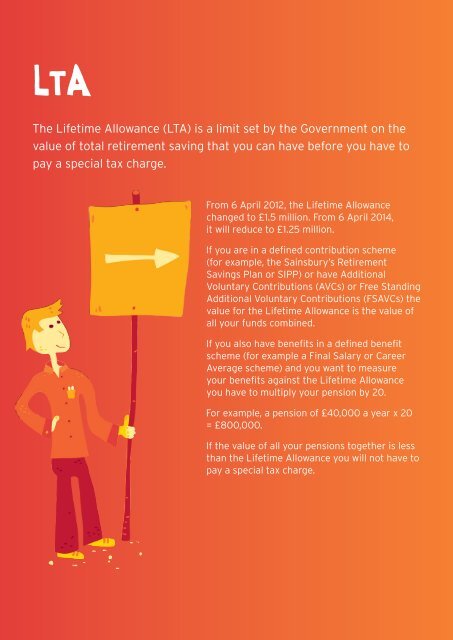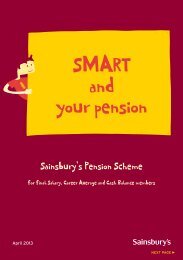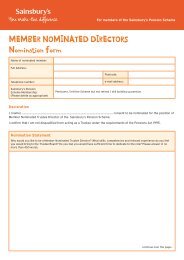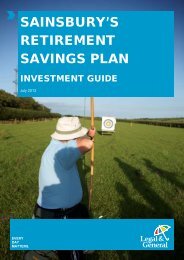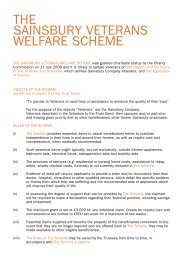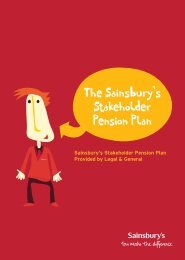The Lifetime Allowance - Sainsburys Pensions
The Lifetime Allowance - Sainsburys Pensions
The Lifetime Allowance - Sainsburys Pensions
Create successful ePaper yourself
Turn your PDF publications into a flip-book with our unique Google optimized e-Paper software.
LTA<br />
<strong>The</strong> <strong>Lifetime</strong> <strong>Allowance</strong> (LTA) is a limit set by the Government on the<br />
value of total retirement saving that you can have before you have to<br />
pay a special tax charge.<br />
From 6 April 2012, the <strong>Lifetime</strong> <strong>Allowance</strong><br />
changed to £1.5 million. From 6 April 2014,<br />
it will reduce to £1.25 million.<br />
If you are in a defined contribution scheme<br />
(for example, the Sainsbury’s Retirement<br />
Savings Plan or SIPP) or have Additional<br />
Voluntary Contributions (AVCs) or Free Standing<br />
Additional Voluntary Contributions (FSAVCs) the<br />
value for the <strong>Lifetime</strong> <strong>Allowance</strong> is the value of<br />
all your funds combined.<br />
If you also have benefits in a defined benefit<br />
scheme (for example a Final Salary or Career<br />
Average scheme) and you want to measure<br />
your benefits against the <strong>Lifetime</strong> <strong>Allowance</strong><br />
you have to multiply your pension by 20.<br />
For example, a pension of £40,000 a year x 20<br />
= £800,000.<br />
If the value of all your pensions together is less<br />
than the <strong>Lifetime</strong> <strong>Allowance</strong> you will not have to<br />
pay a special tax charge.
Here is an example of how to value your total pension benefits:<br />
• Mr A wishes to take his pension from May 2012. He has a defined<br />
benefit scheme pension of £90,000 a year and a fund value of<br />
£200,000 from a defined contribution scheme<br />
• Mr A multiplies his defined benefit scheme pension by 20 and<br />
adds his defined contribution scheme fund value to get a value<br />
for the <strong>Lifetime</strong> <strong>Allowance</strong>; £80,000 x 20 = £1.6 million<br />
£1.6 million + £200,000 = £1.8 million<br />
• £1.8 million - £1.5 million = £300,000. This amount is subject to<br />
the special tax charge<br />
• Mr A has the option to take the £300,000 as either a cash lump sum or as pension.<br />
Cash<br />
• If Mr A decides to take the £300,000 as a lump sum,<br />
there is a one-off tax charge of 55%<br />
• £300,000 x 55% = £165,000 tax charge<br />
Pension<br />
• If Mr A chooses to take the £300,000 as a pension,<br />
then the immediate tax charge is 25%<br />
• £300,000 x 25% = £75,000<br />
• £300,000 - £75,000 = £225,000<br />
• <strong>The</strong> amount left must be used to provide an income<br />
which will be taxed<br />
Until 6 April 2009, it was possible to protect yourself against the tax charge above<br />
if you had, or were likely to have, retirement benefits valued above the <strong>Lifetime</strong><br />
<strong>Allowance</strong>. If you have this protection you will have applied for and received a<br />
Protection Certificate from HMRC. Please also let the <strong>Pensions</strong> Department know.<br />
This calculation is a summary of the main features of the <strong>Lifetime</strong> <strong>Allowance</strong><br />
calculation and is intended to provide an indication of whether you are likely to<br />
be impacted.<br />
If you have calculated the total value of all of your pensions and it is near £1.5 million,<br />
you should contact the <strong>Pensions</strong> Department.<br />
<strong>The</strong> <strong>Pensions</strong> Department is unable to give you advice but can give you information on<br />
protecting your pension.


